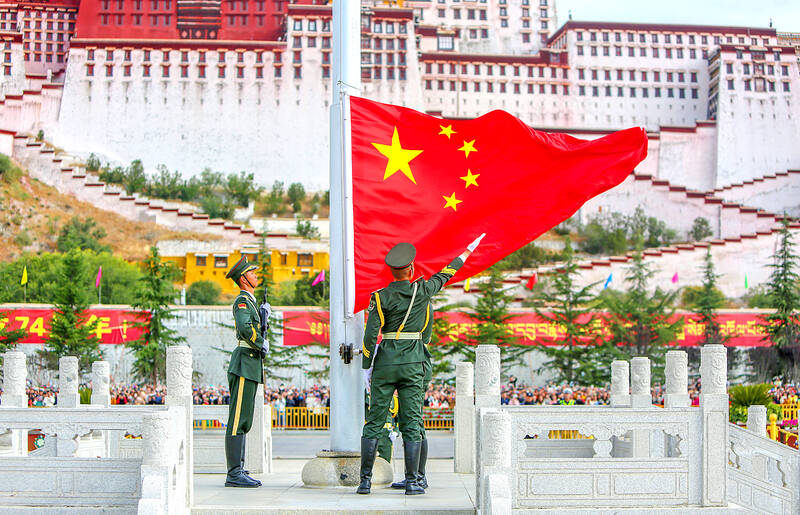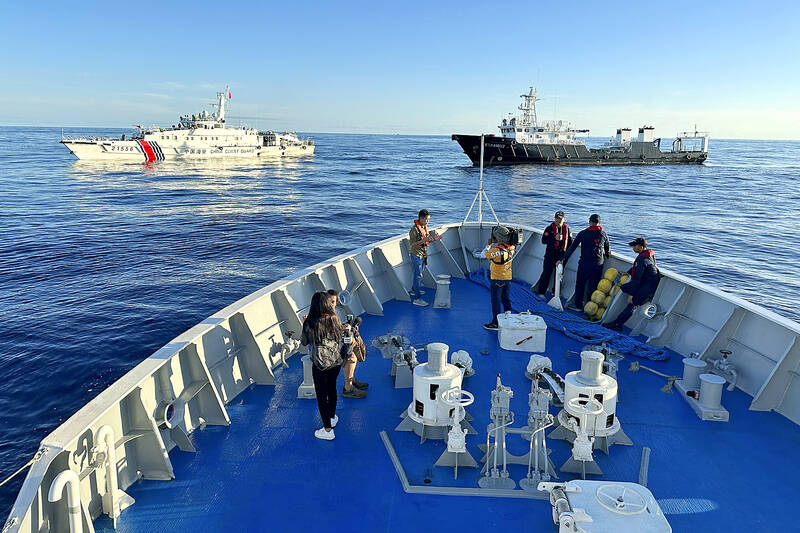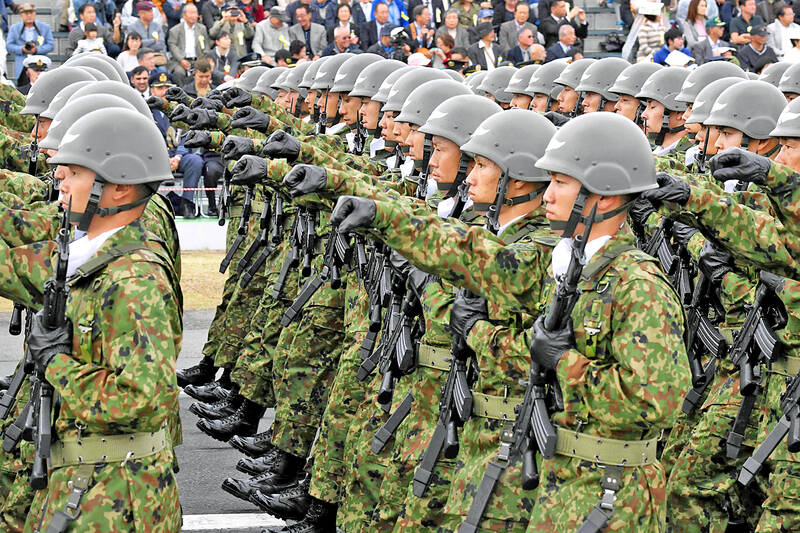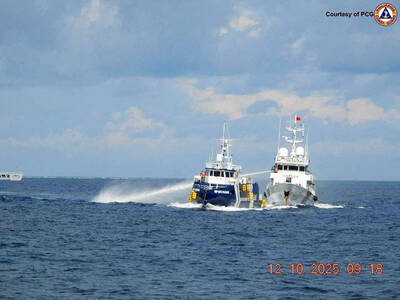In recent months a highly fallacious, deeply ahistorical and ideologically pro-China argument has been put forth in different venues, arguing that the US must provide “assurances” to the People’s Republic of China (PRC) that it does not support “a permanent separation” of Taiwan from China, and that it must return to its rhetorical stance of the 1980s and 1990s.
The latest incarnation of this set of ideas appeared in Foreign Affairs as “Taiwan and the True Sources of Deterrence” (Nov. 30), co-authored by Bonnie Glaser, Jessica Chen Weiss and Thomas Christensen. Echoing ideas they have written elsewhere, they contend that “all sides must recognize that credible assurance is essential for effective deterrence. Credible assurance is not a reward or a carrot. It is a guarantee that a threat is fully conditional on the behavior of its target.”
What should Beijing do? It should dial back its military demonstrations around the island, and change the 2005 “Anti-Secession” law, which codified “its right to use force” (what kind of mind think Beijing has a “right” to attack Taiwan and annex it?) to say that Taiwan will not be invaded unless it opts for “formal independence,” whatever that is. This is the limits of their assurance that Beijing must provide.

Photo: EPA-EFE
WHAT ASSURANCES?
People who write from this alternate reality never ask Beijing to make serious, meaningful changes. The minor moves recommended for Beijing, which few on Taiwan would take seriously, are balanced by a long and detailed list of limits and changes that would take US policy back to the 80s and 90s (before Taiwan was a democracy). It is obvious who they want constrained, and it isn’t the PRC.
If the PRC wants to re-assure Taiwan, it can, on its own, refrain from building up its military. It can’t because Taiwan is only one part of its expansionist dreams, which now include the South China Sea (which, having been taken, must now be held by a naval presence), the Senkakus of Japan (similarly can only be taken by a powerful navy), islands in the Bashi Channel (calls for a powerful navy), along with sundry places in the Himalayan region that are parts of India and other nations.

Photo: AP
In the usual fashion of this style of writing, this context disappears, replaced by a fantasy world in which the future of Taiwan after annexation is not mentioned, never mind all the nations around Taiwan that will be threatened by this unspecified but inevitable future. Tokyo and Manila are not mentioned in the context of Taiwan’s security in the Foreign Affairs piece, a strong signal of a pro-PRC stance. The conflict is instead between only the US, the PRC and Taiwan, a construct that implicitly assigns blame to the US for PRC expansionism. Yet PRC officials have on many occasions threatened the territories of surrounding nations, and annexation of Taiwan will certainly be followed by further war threats (at which point we will have another cycle of history-free recommendations for deterrence that blame the US for PRC expansionism) and later, wars.
In that far-off future when the PRC owns Taiwan, the Taiwanese will suffer greatly, as the peoples of Tibet and East Turkestan suffer now. Nary a mention of that, of course.
The truth is that history has already proven this approach wrong. The list of recommendations they make for the US and Taiwan were dutifully followed by the US from 1980 until around 2008. Three decades of adherence to these policies did not stop the PRC from building up its military and tightening its pressure on Taiwan. The 1990s saw missiles for attacking Taiwan installed and tested in an attempt to intimidate the island’s people during an election. Glaser, Chen Weiss, and Christensen would have us adopt long-failed policies that simply gave the PRC more time to annex the island, and which would further isolate it.

Photo: AFP
Not merely ahistorical, their ideas are absurd. As Michal Thim, a Czech analyst, pointed out on Twitter, the piece posits a world in which the Taiwanese and Americans spend billions on deterring the PRC from attacking Taiwan and then, in the end, hand it over to the PRC. Why on earth would anyone in Taiwan support the waste of billions when they will be delivered to the PRC regardless? Why would Taiwanese youth fight to deter an invasion if in the end they will be handed over to the PRC?
These questions are not merely rhetorical: they point to the logical next step of this argument. I expect this crowd sooner or later to move on to arguing that we should not not bother with deterrence at all since Taiwan is going to be betrayed in the end.
The piece makes a laudable call for the US to clarify its Taiwan policy to the world. Amen. But it does not explicitly mention that under both international law and US policy, Taiwan’s status remains unresolved: it is not part of China. Had any of these writers done so, it would have invalidated their claim that Taiwan is being “permanently separated from China” because Taiwan is not currently part of the PRC. Nor, for that matter, has it ever been part of any Chinese state.
NEW CONSENSUS
The truth is that the US didn’t suddenly change its policy. Slowly — as in any democracy — a new consensus around Taiwan crystallized in response to the PRC’s relentless military build up and savage threats against Taiwan and other US-friendly states. The argument that China needs assurance actually reverses this reality. China is not the actor who is threatened, but the one doing the threatening. It is the potential victims who need assurance: Taiwan, the Philippines, Japan and other nations whose territories the PRC is threatening to violently annex. What assurance would they accept or believe?
Credible assurance, the authors define, “is a guarantee that a threat is fully conditional on the behavior of its target.” The fallacy of this view is that it is the PRC that defines what behavior of the target is acceptable — and it is clear from its behavior for three decades now that Taiwan’s democracy and the needs and dreams of its people are not acceptable, in any form.
Finally, I cannot resist pointing out the very obvious ideological commitments of the piece. The writers state that “[President] Tsai [Ing-wen (蔡英文)] has allowed the teaching of Taiwan’s history separate from the history of China in high schools.” Only a Chinese Nationalist Party (KMT) bitter-ender would insinuate that Tsai is a dictator who exercises personal control over educational policy, and only a bitter-ender would worry that Taiwan’s history is being taught in a Taiwan-centered way. It should be noted that the ideology that centers Taiwan’s history on China is inherently Han supremacist: it ignores the thousands of years of Taiwan prior to the beginning of Han settler colonialism on the island, and defines Taiwan as part of a Han-dominated Chinese state.
Meanwhile, even as I write, the PRC is busy eating away at Bhutan’s territory, constructing villages on border lands it has stolen.
This can only be because Beijing didn’t get the right assurances, right?
Notes from Central Taiwan is a column written by long-term resident Michael Turton, who provides incisive commentary informed by three decades of living in and writing about his adoptive country. The views expressed here are his own.

Many people noticed the flood of pro-China propaganda across a number of venues in recent weeks that looks like a coordinated assault on US Taiwan policy. It does look like an effort intended to influence the US before the meeting between US President Donald Trump and Chinese dictator Xi Jinping (習近平) over the weekend. Jennifer Kavanagh’s piece in the New York Times in September appears to be the opening strike of the current campaign. She followed up last week in the Lowy Interpreter, blaming the US for causing the PRC to escalate in the Philippines and Taiwan, saying that as

Taiwan can often feel woefully behind on global trends, from fashion to food, and influences can sometimes feel like the last on the metaphorical bandwagon. In the West, suddenly every burger is being smashed and honey has become “hot” and we’re all drinking orange wine. But it took a good while for a smash burger in Taipei to come across my radar. For the uninitiated, a smash burger is, well, a normal burger patty but smashed flat. Originally, I didn’t understand. Surely the best part of a burger is the thick patty with all the juiciness of the beef, the

This year’s Miss Universe in Thailand has been marred by ugly drama, with allegations of an insult to a beauty queen’s intellect, a walkout by pageant contestants and a tearful tantrum by the host. More than 120 women from across the world have gathered in Thailand, vying to be crowned Miss Universe in a contest considered one of the “big four” of global beauty pageants. But the runup has been dominated by the off-stage antics of the coiffed contestants and their Thai hosts, escalating into a feminist firestorm drawing the attention of Mexico’s president. On Tuesday, Mexican delegate Fatima Bosch staged a

The ultimate goal of the Chinese Communist Party (CCP) is the total and overwhelming domination of everything within the sphere of what it considers China and deems as theirs. All decision-making by the CCP must be understood through that lens. Any decision made is to entrench — or ideally expand that power. They are fiercely hostile to anything that weakens or compromises their control of “China.” By design, they will stop at nothing to ensure that there is no distinction between the CCP and the Chinese nation, people, culture, civilization, religion, economy, property, military or government — they are all subsidiary